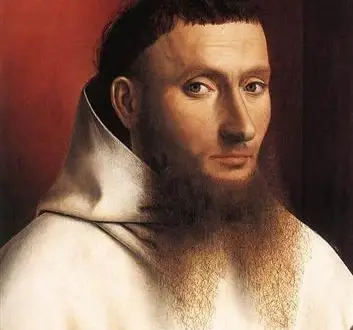Title of Artwork: “Portrait of a Carthusian”

Artwork by Petrus Christus
Year Created 1446
Summary of Portrait of a Carthusian
In 1446, the Early Netherlandish painter Petrus Christus created Portrait of a Carthusian, an oil on oak panel painting. The Metropolitan Museum of Art in New York is home to the Jules Bache Collection, which includes this piece.
As a masterpiece of Early Netherlandish painting and a prominent early example of Trompe l’oeil, it commands a high price in the art world.
All About Portrait of a Carthusian
Pictured here is an anonymous Carthusian monk, caught mid-turn and looking directly at the viewer in Portrait of a Carthusian. Due to the monk’s body being turned to the left, his gaze must be directed over his right shoulder, resulting in a somewhat awkward diagonal pose. To counteract this, Petrus Christus rotates the monk’s head to the right, slightly off-centering him.
Christus brings the viewer closer to one side of the monk’s body by modelling the monk’s right shoulder more than the left. These facial proportions have also been exaggerated; the nose and eyes have been intentionally extended. Using a compositional technique rarely seen in Early Netherlandish Painting, the overall effect is a distorted silhouette.
It’s also worth mentioning Petrus Christus’ use of lighting. It’s a dramatic contrast to see the Monk bathed in such intense light in the room he’s in. Christus’ use of a second, opposing light source behind the monk distinguishes this portrait from that of his contemporaries like Jan van Eyck. An internal reflection of light can be seen to the left, while an unseen window or other external light source appears to bathe the monk in a halo of light.
As a result, the monk (particularly along the hood of his cloak) serves as a meeting point for light coming from both inside and outside the pictorial space. Christus can use a much wider range of colours and shadings because of the two-source lighting setup that surrounds the monk in this scene. The Portrait of a Carthusian’s realistic appearance is due to a complex lighting scheme.
Carthusian depiction features a Trompe-l’oeil fly in the middle of the lower frame. Right around the time Christus was active in the 15th century, artists began incorporating Trompe l’oeil flies into their work. There is a schism among art historians as to how they should be used. In the eyes of many art historians, the fly is a symbol of sin, corruption, and death. In connection with Satan’s nickname Beelzebub—the Lord of the Flies—art historians believe that a fly was used to evoke such images.
As art historian Felix Thülemann recently noted, “a self-conscious representation of superior painterly prowess,” art historians are now beginning to view the inclusion of Trompe-l’oeil flies as a professional calling card. People believe this is why flies are often depicted right next to an artist’s signature in their work (the fly’s placement directly next to ‘Petrus I Me Fecit’ suggests that flies are more representative of’me,’ not the painting).
Information Citations
En.wikipedia.org, https://en.wikipedia.org/.
























